A New Method for Fatigue Evaluation of Titanium Alloy Welded Structures
Abstract
:1. Introduction
2. The Principle of Notch Equivalent Stress and the Proposal of a New Method for Life Prediction
2.1. The Principle of Notch Equivalent Stress
2.2. Notch Stress Equivalent Value Method
2.3. Proposition of Augmented-Reverse Notch Equivalent Stress Method
2.3.1. The Method of Proposing the New Three-Parameter Power Function Model
- (1)
- The fatigue test is carried out on n welded joints loaded with the same stress level, and the n groups of test life under the stress level are obtained as (N11, …N1i, …, N1n);
- (2)
- Perform random sampling (mk) times on the above n fatigue test data (m and k are both positive integers), and divide the sample data after sampling into m groups, with k in each group;
- (3)
- Calculate the corresponding mean value of each group of data. The calculation formula of the life mean value of group j is as follows (1 ≤ j ≤ m):
- (4)
- Count the m mean values obtained in step (3) and determine the distribution law. If it is a normal distribution, the fatigue life N under the stress level in the new three-parameter power function S-N curve is the normal distribution mean value. If it is a skewed distribution, the fatigue life N under the stress level in the new three-parameter power function S-N curve is the median value of the skewed distribution;
- (5)
- Repeat steps (1~4) to determine the fatigue life under other stress levels in the new three-parameter power function S-N curve, then the new three-parameter power function S-N curve calculation model is as follows:
2.3.2. The Proposed Method of the Notch Equivalent Stress Correction Factor
- (1)
- Perform fatigue test on n groups of welded joints, and obtain n groups of test data as (S1, N1), …, (Si, Ni), …, (Sn, Nn);
- (2)
- According to the methods described in Section 2.1 and Section 2.2, calculate the notch equivalent stress at each stress amplitude Si at the weld position of the welded structure: (σy1, …, σyi, …, σyn);
- (3)
- Calculate the notch equivalent stress correction factor fas, the formula is as follows:where is the corrected notch equivalent stress, is the notch equivalent stress, and fas is a correction factor introduced to take into account the influence of material properties and welding performance on fatigue strength, m and C are material parameters.
- (4)
- Take the mean value of the obtained n notch equivalent stress correction factors, as shown in Equation (10):
3. Establishment of a New Three-Parameter Power Function S-N Curve for Titanium Alloy Welded Structures
3.1. Selection of Test Specimens and Determination of Fatigue Life
3.2. A New Three-Parameter Power Function S-N Curve
3.3. Comparison of Goodness of Fit between Traditional and New Three-Parameter Power Function Models
4. Proposition of Notch Equivalent Stress Correction Factor of Titanium Alloy Welded Structures
4.1. Fatigue Test
4.2. Determination of Notch Equivalent Stress and Prediction of Fatigue Life
4.3. Correction of the Calculation Formula of the Notch Equivalent Stress
4.4. The Test Results Are Compared with the Two Prediction Results before and after the Notch Equivalent Stress Correction
5. Verification of Augmented-Reverse Notch Equivalent Stress Method
- (1)
- The existing T-joint is shown in Figure 9, and its material is TA5 titanium alloy. The same loading and restraint methods as those in literature [28] are adopted, and the loading position and loading direction are shown in Figure 9. Literature [28] analyzed the effect of MIG welding on the residual stress and fatigue performance of the T-joint at the weld toe. Combined with the analysis results obtained from the fatigue test, the correctness of the augmented-reverse notch equivalent stress method is verified.
- (2)
- The existing cross joint is shown in Figure 11, and its material is TC4 titanium alloy, using the same loading and constraining methods as in the literature [29,30]. The loading position and loading direction are shown in Figure 11. Combined with the data obtained from the fatigue test, the correctness of the augmented-reverse notch equivalent stress method is verified.
6. Conclusions
- (1)
- At present, most of the existing fatigue studies of titanium alloys are based on the S-N curve, and there are very few studies on the fatigue properties of titanium alloy welded structures with stress singularities. This study proposes a new fatigue life prediction method that takes stress singularities into account, namely the augmented-reverse notch equivalent stress method. A new three-parameter power function model and a calculation method of the notch equivalent stress correction coefficient are proposed. The augmented-reverse notch equivalent stress method is obtained by combining the above two.
- (2)
- Through the research on the classification of joint grades in the BS7608 standard, the welded joint structure with the same joint grade is found, and the classification of titanium alloy welded joints is compared with this. Combined with the fatigue test data of titanium alloy welded joints, the fatigue life under each stress range was determined. A new three-parameter power function model of titanium alloy welded structure proposed in this study was established. According to the calculation method of the notch equivalent stress correction factor proposed in this study, the correction factor suitable for the titanium alloy welded structure is obtained. Two prediction models, the traditional three-parameter power function model and the new three-parameter power function model, were selected to quantitatively characterize the relationship between the stress range and fatigue life of titanium alloy welded structures, and the two fitting results were compared and analyzed.
- (3)
- The augmented-reverse notch equivalent stress method was verified using fatigue test data different from the above titanium alloy welded structures. The verification results show that the augmented-reverse notch equivalent stress method improves the effectiveness and accuracy of fatigue life evaluation and finds a new life evaluation method for titanium alloy welded structures with stress singularities.
Author Contributions
Funding
Institutional Review Board Statement
Informed Consent Statement
Data Availability Statement
Conflicts of Interest
References
- Guo, L.; He, W.X.; Zhou, P.; Liu, B. Research status and development prospect of titanium and titanium alloy products in China. Hot Work. Technol. 2020, 22, 22–28. [Google Scholar]
- Zafar, T.; Zhang, Y.W.; Wang, Z.L. An efficient kriging based method for time-dependent reliability based robust design optimization via evolutionary algorithm. Comput. Methods Appl. Mech. Eng. 2020, 372, 113386. [Google Scholar] [CrossRef]
- Zhi, P.P.; Li, Y.H.; Chen, B.Z.; Shi, S. Bounds-based structure reliability analysis of bogie frame under variable load cases. Eng. Fail. Anal. 2020, 114, 104541. [Google Scholar] [CrossRef]
- Zhao, D.Y.; Yu, S.; Wang, Z.L.; Wu, J. A box moments approach for the time-variant hybrid reliability assessment. Struct. Multidiscip. Optim. 2021, 64, 4045–4063. [Google Scholar] [CrossRef]
- Zhi, P.P.; Li, Y.H.; Chen, B.Z.; Bai, X.N.; Sheng, Z.Q. Fuzzy design optimization-based fatigue reliability analysis of welding robots. IEEE Access 2020, 8, 64906–64917. [Google Scholar] [CrossRef]
- Jing, L.; Liu, K. Review on wheel-rail dynamic responses caused by wheel tread defects. J. Traffic Transp. Eng. 2021, 21, 285–315. [Google Scholar]
- Wang, P.; Pei, X.J.; Qian, H.L.; Dong, P.S. Unique fatigue design method of welded structures and application. J. Mech. Eng. 2021, 57, 349–360. [Google Scholar]
- Zhi, P.P.; Wang, Z.L.; Chen, B.Z.; Sheng, Z.Q. Time-variant reliability-based multi-objective fuzzy design optimization for anti-roll torsion bar of EMU. CMES-Comput. Modeling Eng. Sci. 2022, 131, 1001–1022. [Google Scholar] [CrossRef]
- Wang, A.B.; Gao, X.G.; Xiao, J.H. Study and optimization of mechanism of high frequency fatigue fracture of rail clip. J. China Railw. Soc. 2021, 43, 93–99. [Google Scholar]
- Xue, Q.W.; Wang, J. Fuzzy proportional boundary element method for solving uncertain force/thermal singularity problems. J. Basic Sci. Eng. 2021, 29, 889–900. [Google Scholar]
- Heikki, R.; Pasquale, G.; Jasmin, J.; Jani, R.; Pauli, L. Fatigue strength modelling of high-performing welded joints. Int. J. Fatigue 2020, 135, 105555. [Google Scholar]
- Lillemäe, I.; Liinalampi, S.; Remes, H.; Antti, I.; Ari, N. Fatigue strength of thin laser-hybrid welded full-scale deck structure. Int. J. Fatigue 2016, 95, 282–292. [Google Scholar] [CrossRef]
- Malitckii, E.; Remes, H.; Lehto, P.; Yagodzinskyy, Y.; Bossuyt, S.; Hänninen, H. Strain accumulation during microstructurally small fatigue crack propagation in bcc Fe-Cr ferritic stainless steel. Acta Mater. 2018, 144, 51–59. [Google Scholar] [CrossRef]
- Shiratsuchi, T.; Osawa, N. Investigation of thickness and bead profile effects on fatigue strength of welded joints based on relative stress gradient. Int. J. Fatigue 2020, 134, 105520. [Google Scholar] [CrossRef]
- Yang, J.; Li, J.L.; Xiong, J.T.; Liao, J.H.; Jin, F. Effect of welding parameters on microstructure characteristics and fatigue properties of dissimilar joints prepared by linear friction welding on TC11 and TC17 titanium alloys. Weld. World 2020, 64, 683–695. [Google Scholar] [CrossRef]
- Zhao, F.; Li, A.Q.; Li, W.R.; Li, W.R.; Shen, S.; Song, G.B.; Wang, C.J.; Wang, B. Wind-Induced fatigue analysis of high-rise steel structures using equivalent structural stress method. Appl. Sci. 2017, 7, 71–75. [Google Scholar]
- Ebrahimi, S.H. Residual stress effects on crack-tip stress singularity in XFEM fracture analysis. Eur. J. Mech.-A/Solids 2021, 86, 104191. [Google Scholar] [CrossRef]
- Gao, S.; Xu, L.; Wang, D.Z.; Nigel, B. Research of stress assessment for the 135-degree sheet corner based on singularity strength theory. J. Wuhan Univ. Technol. 2013, 35, 72–79. [Google Scholar]
- Cai, H.; Li, W.Z.; Wang, Z.F.; Yao, D.D.; Liu, C. Welding technology of titanium alloy high speed rail bogie frame. Electr. Weld. Mach. 2020, 50, 52–56. [Google Scholar]
- Lazzarin, P.; Tovo, R. Notch stress intensity factor approach to the stress analysis of welds. Fatigue Fract. Eng. Mater. Struct. 1998, 21, 1089–1103. [Google Scholar] [CrossRef]
- Williams, M.L. Stress singularities resulting from various boundary conditions in angular corners of plates in extension. J. Appl. Mech. 1952, 19, 526–528. [Google Scholar] [CrossRef]
- Sih, G.C.; Paris, P.C.; Erdogan, F. Crack-tip, stress-intensity factors for plane extension and plate bending problems. J. Appl. Mech. 1962, 29, 306–312. [Google Scholar] [CrossRef]
- Gao, S.; Xu, L.; Nigel, B.; Wang, D.Z. Fatigue characteristics assessment method based on singularity strength theory. Chin. J. Ship Res. 2014, 9, 60–68. [Google Scholar]
- BS7608-2014; Fatigue Design and Assessment of Steel Structures. British Standard Institute: London, UK, 2014.
- Hui, L.; Lu, J.C.; Zhou, S.; An, J.L.; Zhou, G.Y.; Liu, X.P. Effect of heat treatment on fatigue properties of TC4 titanium alloy by laser double beam welded joint. J. Jilin Univ. Eng. Technol. Ed. 2021, 10, 589. [Google Scholar] [CrossRef]
- Zhao, W.L.; Liu, X.G.; Xie, P.Y.; Guo, H.D. Study on shear fatigue performance of TC4 titanium alloy diffusion bonded joints. Aeroengine 2020, 46, 99–102. [Google Scholar]
- Iwata, T.; Matsuoka, K. Fatigue strength of CP grade 2 titanium fillet welded joint for ship structure. Weld. World 2004, 48, 40–47. [Google Scholar] [CrossRef]
- Li, R.W.; Sun, P.P.; Li, P.; Yang, Q.Y.; Zhang, Y.H.; Li, Y.Z. Influence of weld toe by TIG dressing on the fatigue behavior of T-joint of titanium alloy. Dev. Appl. Mater. 2017, 32, 41–46. [Google Scholar]
- Zhao, X.H.; Wang, D.P.; Wang, X.B.; Deng, C.Y.; Zu, Z.Q. Improvement of fatigue performance of TC4 Ti-alloy welded joints by loading ultrasonic peening. Trans. China Weld. Inst. 2010, 31, 57–60. [Google Scholar]
- Yang, Y.T.; Zhang, Y.Y.; Yu, W. Property of titanium alloy welded joints treated with ultrasonic peening. Dev. Appl. Mater. 2007, 28–32. [Google Scholar] [CrossRef]
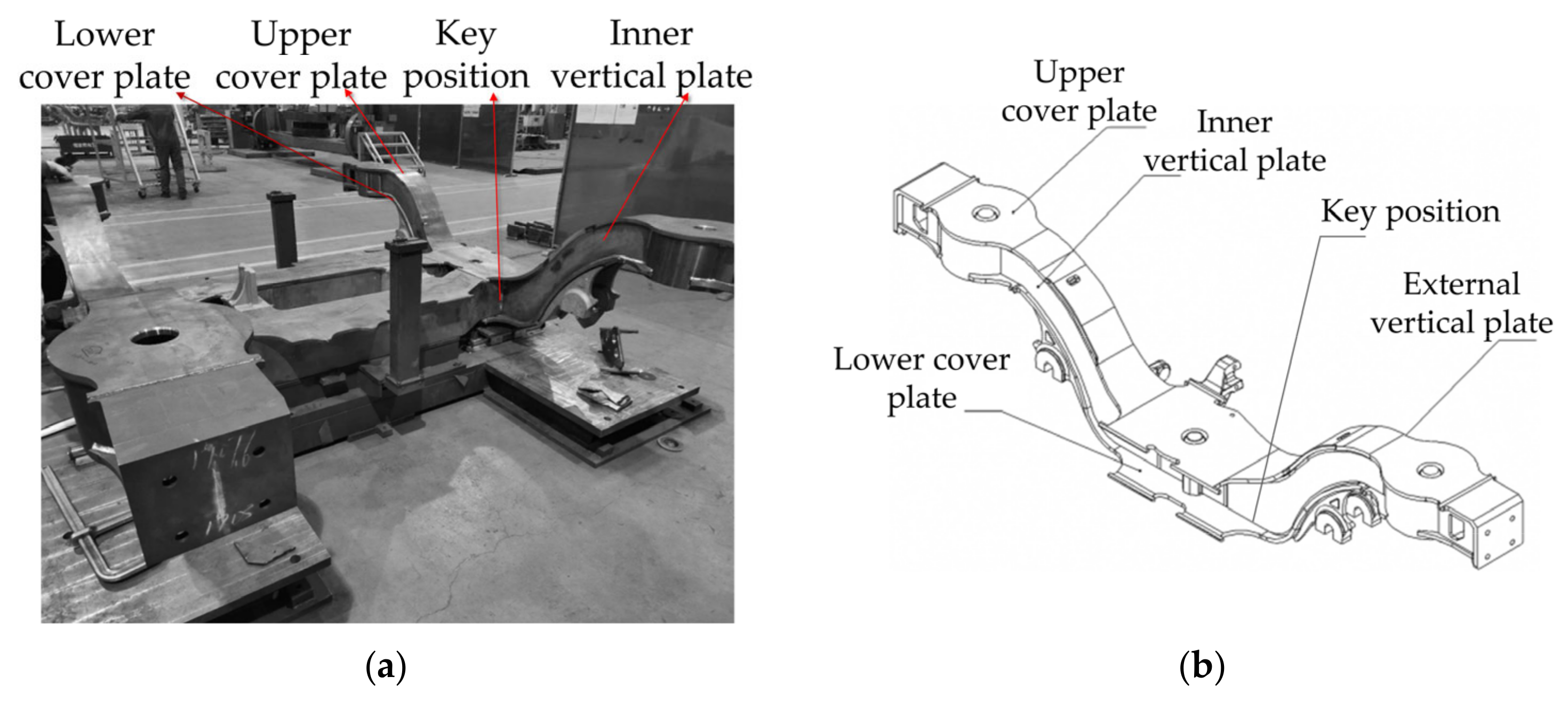
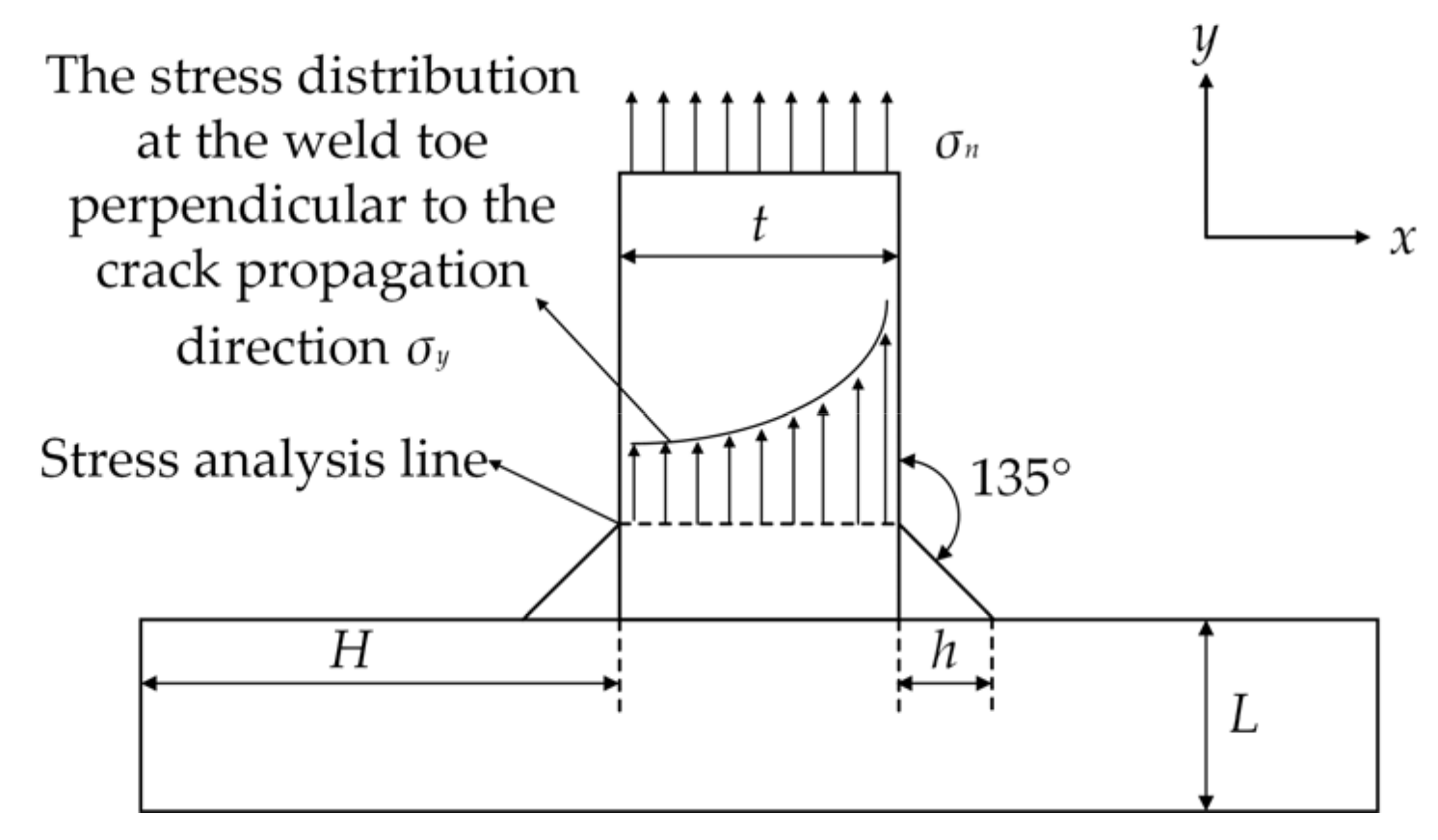
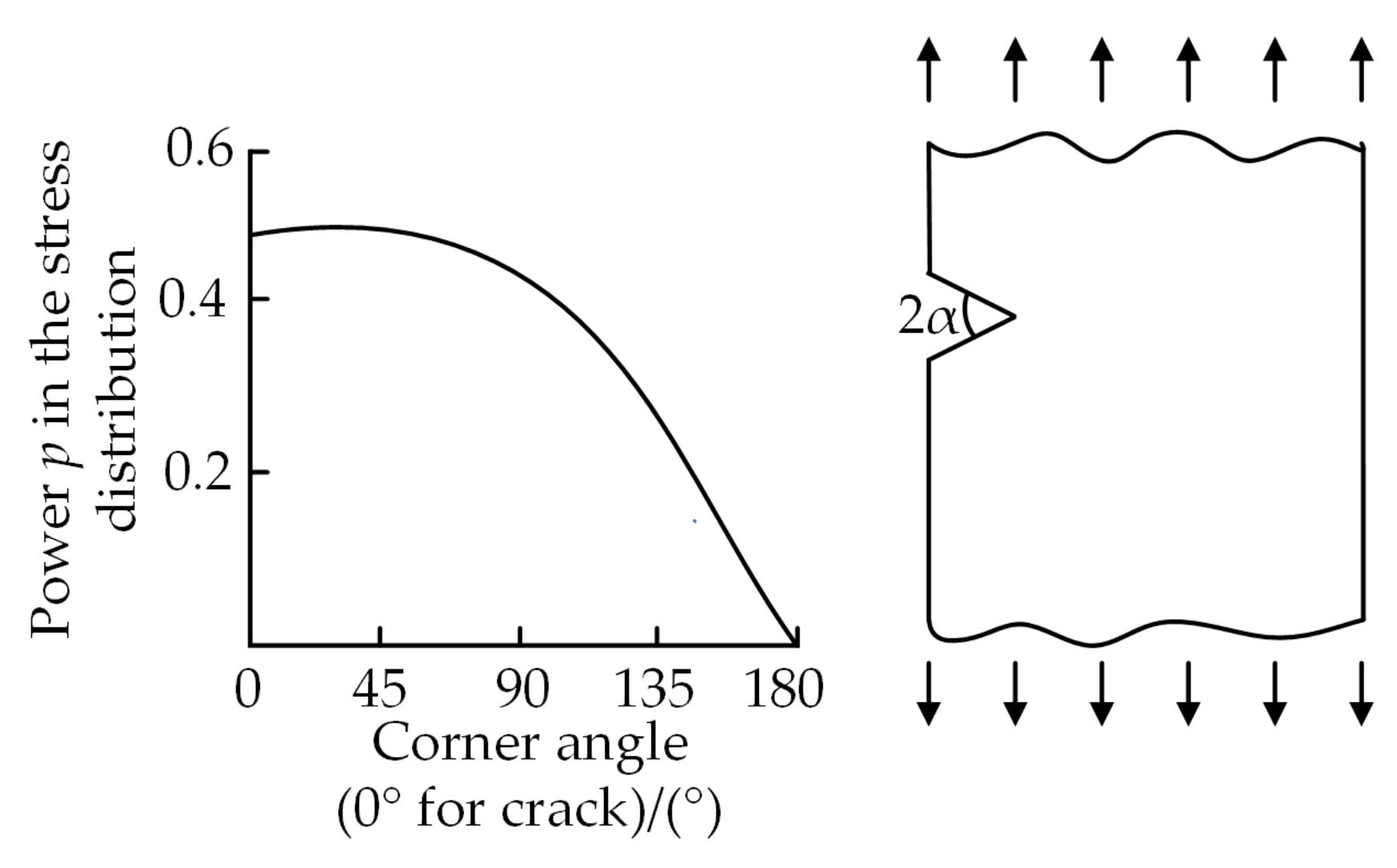
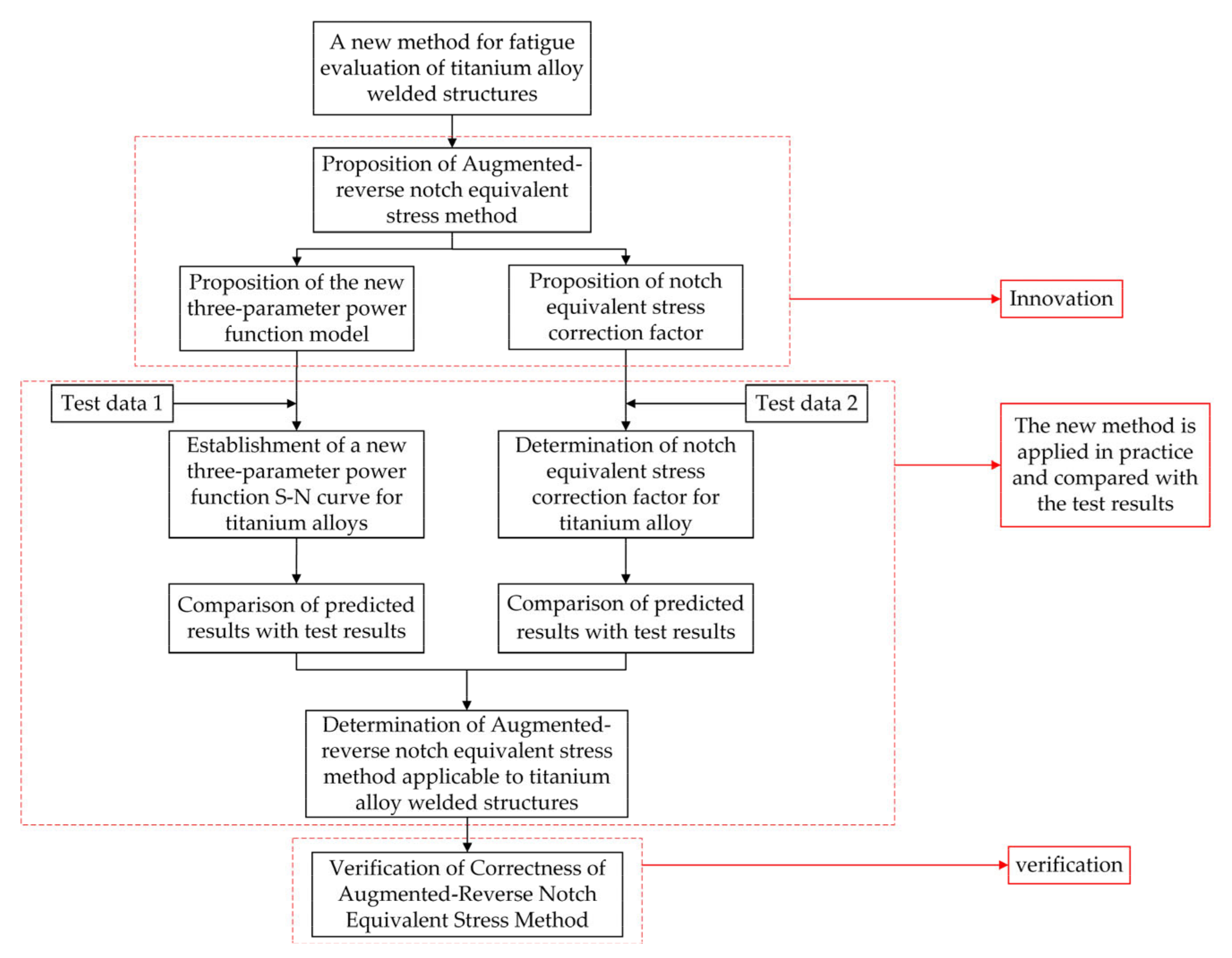

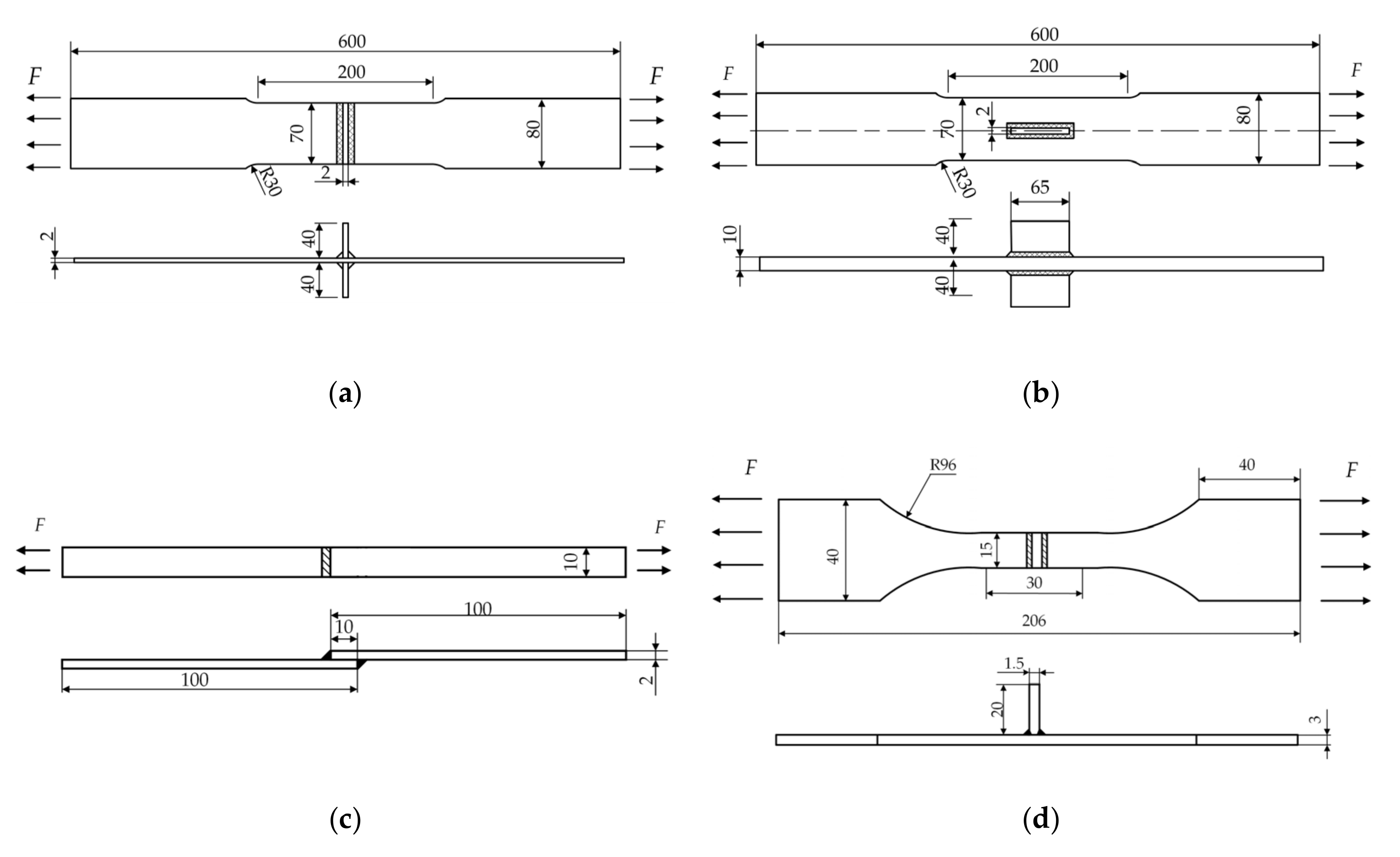
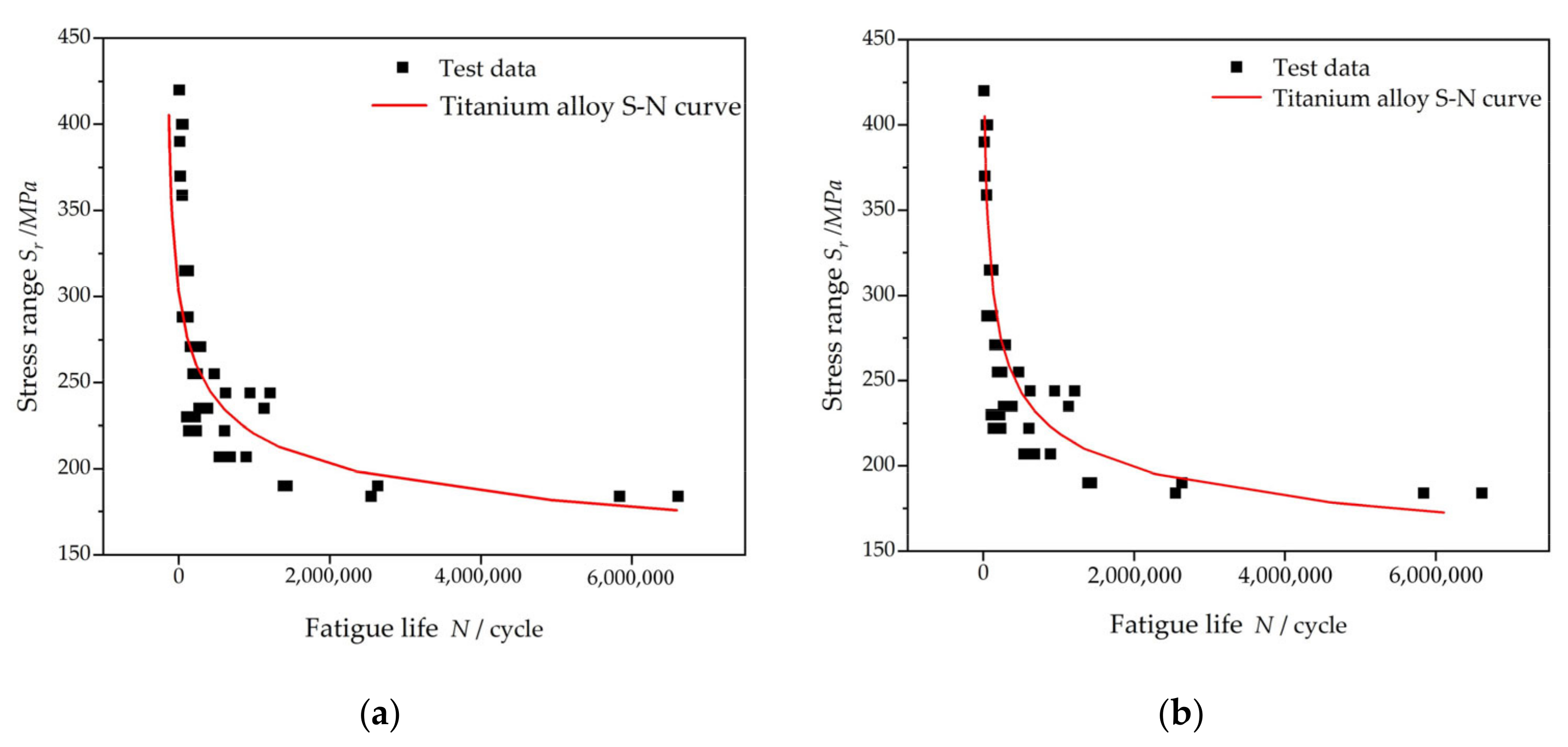

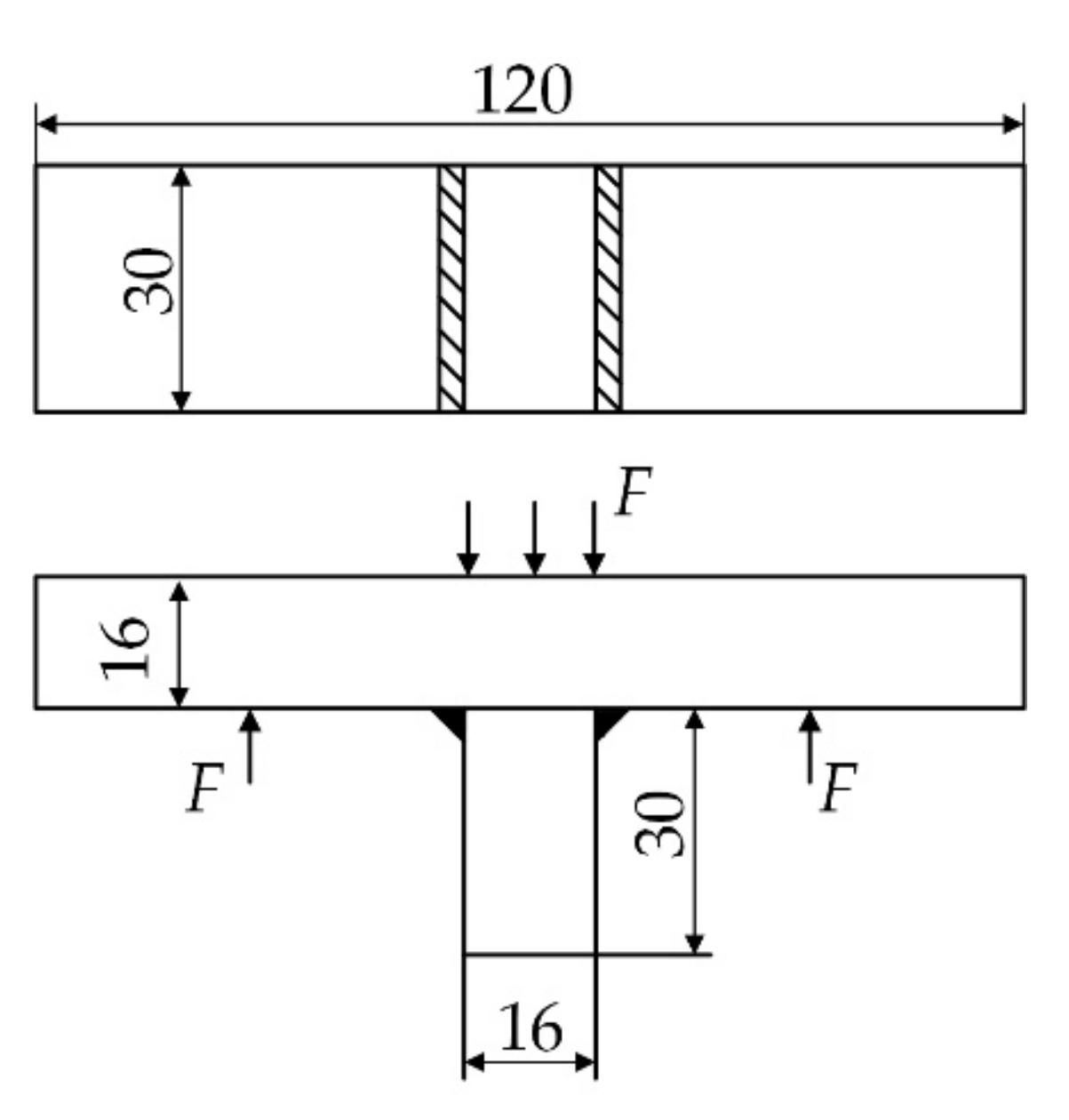
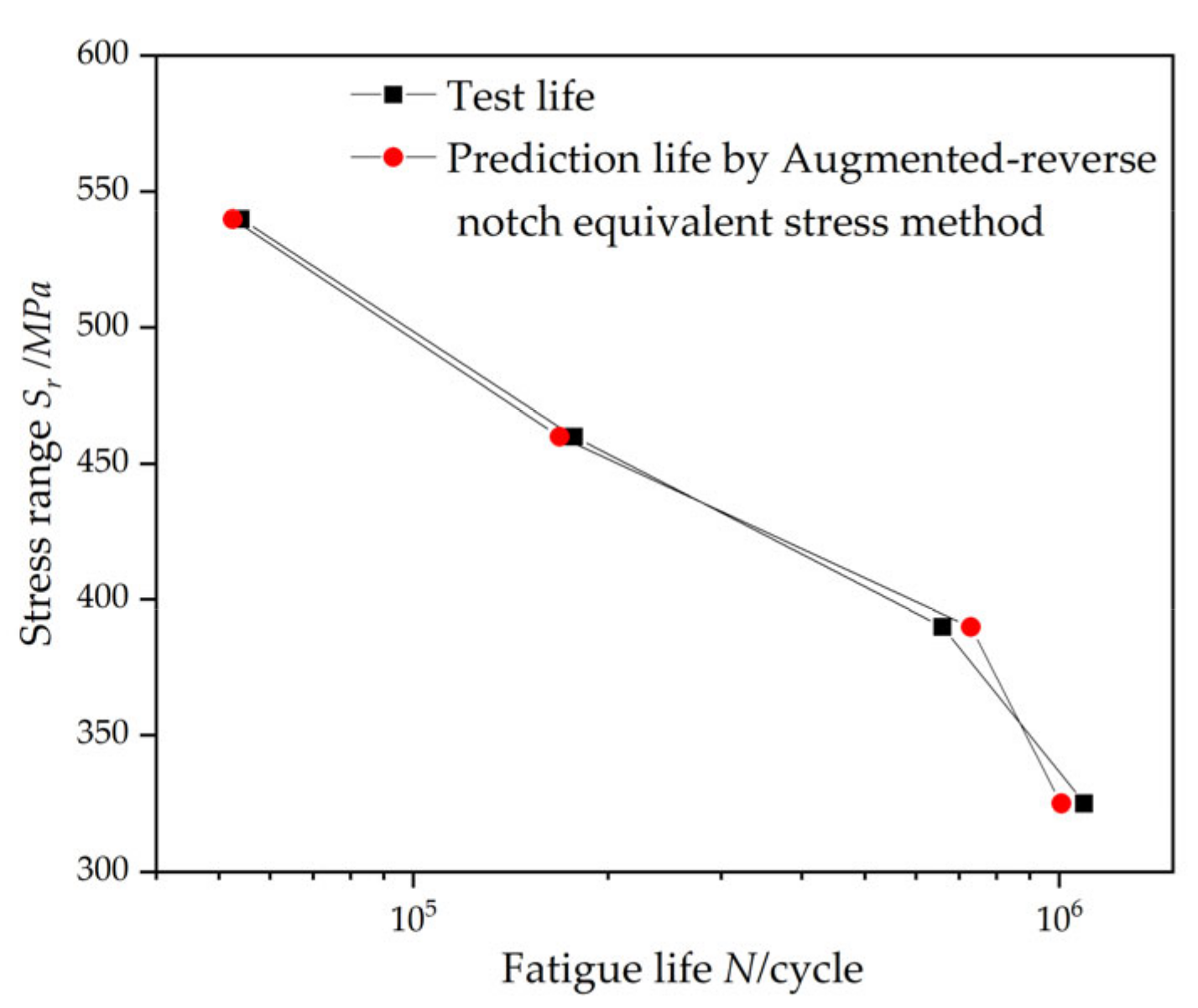
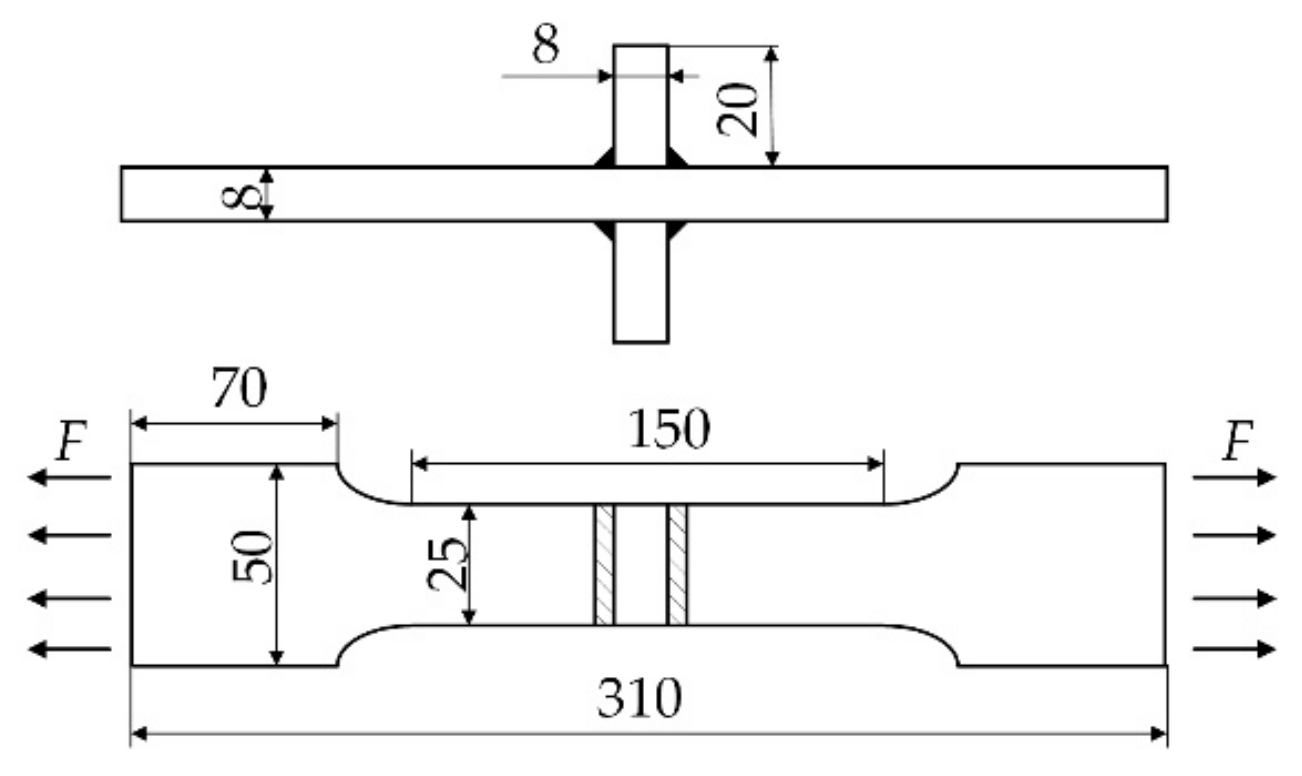

| 0 | 2.000 | 0.500 | 1.000 |
| 1/6 | 1.833 | 0.501 | 1.071 |
| 1/4 | 1.750 | 0.505 | 1.166 |
| 1/3 | 1.667 | 0.512 | 1.312 |
| 1/2 | 1.500 | 0.544 | 1.841 |
| 3/4 | 1.250 | 0.674 | 4.153 |
| as/mm | |||
|---|---|---|---|
| 1~10 | 10~100 | 100~1000 | |
| A/mm−1 | 0.52067 | 0.80875 | 2.0598 |
| B | 0.13915 | 0.0565 | 0.00928 |
| C/mm−1 | −0.01092 | −8.41088 × 10−4 | −1.97016 × 10−5 |
| D/mm−2 | 6.35004 × 10−4 | 7.23825 × 10−6 | 1.90644 × 10−8 |
| E/mm−3 | −1.60256 × 10−5 | −2.48689 × 10−8 | −6.86043 × 10−12 |
| Type of Welded Joint | Loading Frequency (f) | Stress Ratio (R) |
|---|---|---|
| Cross joint | 5 Hz | 0.00 |
| Lap joint | 10 Hz | 0.10 |
| T-joint | 10 Hz | 0.06 |
| Number of Test Groups | Type of Welded Joint | Logarithmic Stress Range Sr/MPa | Logarithmic Fatigue Life lgN/Cycle |
|---|---|---|---|
| 1 | Cross joint with transverse vertical plate | 2.2648 | 6.4058, 6.8202, 6.7662 |
| 2 | 2.2788 | 6.4206, 6.1412, 6.1562 | |
| 3 | 2.3160 | 5.9492, 5.8316, 5.7289 | |
| 4 | 2.3464 | 5.1135, 5.3650, 5.7816 | |
| 5 | 2.3617 | 5.0233, 5.3374, 5.3045 | |
| 6 | Cross joint with longitudinal vertical plate | 2.3711 | 5.4236, 6.0530, 5.5801 |
| 7 | 2.3874 | 6.0829, 5.7923, 5.9747 | |
| 8 | 2.4065 | 5.3891, 5.6703, 5.2765 | |
| 9 | 2.4330 | 5.4663, 5.1848, 5.2584 | |
| 10 | 2.4594 | 4.6801, 4.8922, 5.0905 | |
| 11 | Lap joint | 2.5549 | 4.6423, 4.6435, 4.6544 |
| 12 | 2.5682 | 4.1500, 4.1700, 4.3000 | |
| 13 | 2.5911 | 4.0414, 4.1067, 4.1289 | |
| 14 | 2.6232 | 3.6149, 3.9306, 3.8156 | |
| 15 | T-joint | 2.6021 | 4.7361, 4.7534, 4.5563 |
| Fatigue Life Characterization Model of Titanium Alloy Welded Structures | Coefficient of Determination R2 |
|---|---|
| Traditional three-parameter power function model | 0.8452 |
| New three-parameter power function model | 0.9407 |
| Group Number | Stress Range Sr/MPa | Test Fatigue Life lgN/Cycle | Group Number | Stress Range Sr/MPa | Test Fatigue Life lgN/Cycle |
|---|---|---|---|---|---|
| 1 | 149.50 | 6.6247 | 11 | 207.00 | 5.8316 |
| 2 | 151.05 | 6.6635 | 12 | 209.10 | 5.7289 |
| 3 | 160.00 | 6.6069 | 13 | 217.00 | 5.7421 |
| 4 | 176.00 | 6.0841 | 14 | 218.50 | 5.2760 |
| 5 | 183.00 | 5.9511 | 15 | 223.00 | 5.3650 |
| 6 | 190.00 | 6.1412 | 16 | 230.00 | 5.3374 |
| 7 | 190.80 | 5.7544 | 17 | 231.00 | 5.3050 |
| 8 | 195.50 | 5.6544 | 18 | 234.15 | 5.4236 |
| 9 | 200.70 | 5.6988 | 19 | 241.50 | 5.1532 |
| 10 | 204.00 | 5.9492 |
| Group Number | Stress Range Sr/MPa | Notch Equivalent Stress σy/MPa | Predicted Fatigue Life lgN/Cycle |
|---|---|---|---|
| 1 | 149.50 | 202.07 | 6.1983 |
| 2 | 151.05 | 204.17 | 6.1652 |
| 3 | 160.00 | 216.27 | 5.9801 |
| 4 | 176.00 | 237.89 | 5.6736 |
| 5 | 183.00 | 247.36 | 5.5482 |
| 6 | 190.00 | 256.82 | 5.4275 |
| 7 | 190.80 | 257.90 | 5.4140 |
| 8 | 195.50 | 264.25 | 5.3357 |
| 9 | 200.70 | 271.28 | 5.2513 |
| 10 | 204.00 | 275.74 | 5.1989 |
| 11 | 207.00 | 279.80 | 5.1519 |
| 12 | 209.10 | 282.63 | 5.1195 |
| 13 | 217.00 | 293.31 | 5.0002 |
| 14 | 218.50 | 295.34 | 4.9781 |
| 15 | 223.00 | 301.42 | 4.9125 |
| 16 | 230.00 | 310.88 | 4.8131 |
| 17 | 231.00 | 312.24 | 4.7992 |
| 18 | 234.15 | 316.49 | 4.7556 |
| 19 | 241.50 | 326.43 | 4.6562 |
| Group Number | Stress Range Sr/MPa | Notch Equivalent Stress Correction Factor fas | Group Number | Stress Range Sr/MPa | Notch Equivalent Stress Correction Factor fas |
|---|---|---|---|---|---|
| 1 | 149.50 | 0.87583 | 11 | 207.00 | 0.80948 |
| 2 | 151.05 | 0.85645 | 12 | 209.10 | 0.82735 |
| 3 | 160.00 | 0.82289 | 13 | 217.00 | 0.79396 |
| 4 | 176.00 | 0.88016 | 14 | 218.50 | 0.91152 |
| 5 | 183.00 | 0.88224 | 15 | 223.00 | 0.86874 |
| 6 | 190.00 | 0.80095 | 16 | 230.00 | 0.84955 |
| 7 | 190.80 | 0.89955 | 17 | 231.00 | 0.85445 |
| 8 | 195.50 | 0.90564 | 18 | 234.15 | 0.81243 |
| 9 | 200.70 | 0.87008 | 19 | 241.50 | 0.85681 |
| 10 | 204.00 | 0.79187 |
Publisher’s Note: MDPI stays neutral with regard to jurisdictional claims in published maps and institutional affiliations. |
© 2022 by the authors. Licensee MDPI, Basel, Switzerland. This article is an open access article distributed under the terms and conditions of the Creative Commons Attribution (CC BY) license (https://creativecommons.org/licenses/by/4.0/).
Share and Cite
Zhang, Z.; Wang, Y.; Yu, C.; Dong, Q. A New Method for Fatigue Evaluation of Titanium Alloy Welded Structures. Appl. Sci. 2022, 12, 5966. https://doi.org/10.3390/app12125966
Zhang Z, Wang Y, Yu C, Dong Q. A New Method for Fatigue Evaluation of Titanium Alloy Welded Structures. Applied Sciences. 2022; 12(12):5966. https://doi.org/10.3390/app12125966
Chicago/Turabian StyleZhang, Zhe, Yuedong Wang, Chunyang Yu, and Qi Dong. 2022. "A New Method for Fatigue Evaluation of Titanium Alloy Welded Structures" Applied Sciences 12, no. 12: 5966. https://doi.org/10.3390/app12125966
APA StyleZhang, Z., Wang, Y., Yu, C., & Dong, Q. (2022). A New Method for Fatigue Evaluation of Titanium Alloy Welded Structures. Applied Sciences, 12(12), 5966. https://doi.org/10.3390/app12125966






